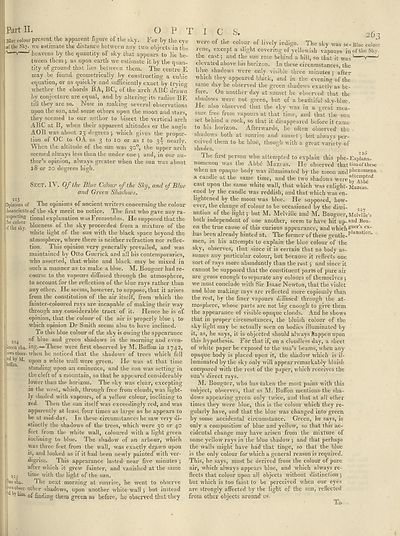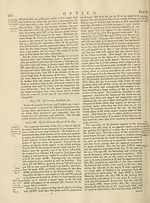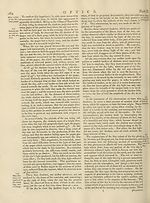Encyclopaedia Britannica > Volume 15, NIC-PAR
(283) Page 263
Download files
Complete book:
Individual page:
Thumbnail gallery: Grid view | List view

Part 1L
Blue colour present the apparent figure of the sky. For by the eye
ef the Sky. vre estimate the distance between any two objects in tile
r—'' heavens by the quantity of sky that appears to lie be¬
tween them ; as upon earth we estimate it by the quan¬
tity of ground that lies between them. The centre E
may be found geometrically by constructing a cubic
equation, or as quickly and sufficiently exact by trying
whether the chords liA, BC, of the arch ABC drawn
by conjecture are equal, and by altering its radius BE
till they are so. Now in making several observations
upon the sun, and some others upon the moon and stars,
they seemed to our author to bisect the vertical arch
ABC at B, when their apparent altitudes or the anode
AOB was about 23 degrees j which gives the propor¬
tion of OC to OA as 3 to 10 or as 1 to 3y nearly.
When the altitude of the sun was 30°, the upper arch
seemed always less than the under one 5 and, in our au¬
thor’s opinion, always greater when the sun was about
18 or 20 degrees high.
o P t i c s.
Sect. IV. Of the Elite Colour of the Sky, and of Blue
and Green Shadows.
223
he colour
il if the sky.
224
Opinions of The opinions of ancient writers concerning the colour
i jtheancients of the sky merit no notice. The first who gave anv ra-
respecting tional explanation wasFromondus. He supposed that the
blueness of the sky proceeded from a mixture of the
white light of the sun with the black space beyond the
atmosphere, where there is neither refraction nor reflec¬
tion This opinion very generally prevailed, and was
maintained by Otto Guerick and all his contemporaries,
who asserted, that white and black may be mixed in
such a. manner as to make a blue. M. Bouguer had re¬
course to the vapours diffused through the atmosphere,
to account for the reflection of the blue rays rather than
any other. He seems, however, to suppose, that it arises
from the constitution of the air itself, from which the
fainter-coloured rays are incapable of making their way
through any considerable tract of it. Hence he is of
opinion, that the colour of the air is properly blue ; to
which opinion Dr Smith seems also to have inclined.
To this blue colour of the sky is owing the appearance
of blue and green shadows in the morning and even-
reeiTslia-—These were first observed by M. Buffon in 1742,
ows obser-when he noticed that the shadows of trees which fell
«1 uy M. Upon a white wall were green. He was at that time
standing upon an eminence, and the sun was setting in
the elelt of a mountain, so that he appeared considerably
lower than the horizon. The sky ivas clear, excepting
in the west, which, through free from clouds, was light¬
ly shaded with vapours, of a yellow colour, inclining to
red. Then the sun itself was exceedingly red, and was
apparently at least four times as large as he appears to
he at mid-day. In these circumstances he saw very di¬
stinctly the shadows of the trees, which were 30 or 40
feet from the white wall, coloured with a light green
inclining to blue. The shadow' of an arbour, which
■was three feet from the wall, was exactly drawn upon
it, and looked as if it had been newly painted with ver-
digrise. This appearance lasted near five minutes ;
after which it grew fainter, and vanished at the same
time with the light of the sun.
1 he next morning at sunrise, he went to observe
db°rei °ther s'lla^ows5 uPon another white wall 3 but instead
1 °) ha ol finding them green as before, he observed that they
lue sha-
263
were of the colour of lively indigo. The sky was se-B!ue colour
lene, except a slight covering of yellowish vapours in of the Sky.
the east.; and the sun rose behind a hill, so that it was * v ' ''
elevated above his horizon. In these circumstances, the
blue shadows were only visible three minutes ; after
which they appeared black, and in the evening of the
same day he observed the green shadows exactly as be¬
fore. On another day at sunset he observed that the
shadows were not green, but of a beautiful sky-blue.
He also observed that the sky was in a great mea¬
sure free from vapours at that time, and that the sun
set behind a rock, so that it disappeared before it came
to his horizon. Afterwards, he often observed the ,
shadow's both at sunrise and sunset ; hut always per¬
ceived them to be blue, though with a great variety of
shades. • ■
ihe first person who attempted to explain this phe-Explana-
nomenon was the Abbe Mazeas. He observed that bon of these
when an opaque body was illuminated by the moon andPllenomena
a candle at the same time, and the two shadows were
cast upon the same white wall, that which tvas enlight- Mazeas\
ened by the candle was reddish, and that which was en¬
lightened by the moon was blue. He supposed, how¬
ever, the change of colour to he occasioned by the dimi-
nation of the light 5 but M-. Melville and M. Bouguer, Melville’s
both independent of one another, seem to have hit up- and Bou-
on the true cause of this curious appearance, and which Suer s ex'
has been already hinted at . The former of these gentle-^ ! "
men, in his attempts to explain the blue colour of the
sky, observes, that since it is certain that 110 body as¬
sumes any particular.colour, but because it reflects one
sort of rays more abundantly than the rest j and since it
cannot be supposed that the constituent parts of pure air
are gross enough to separate any colours of themselves ;
we must conclude with Sir Isaac Newton, that the violet
and blue making rays are reflected more copiously than
the rest, by the finer vapours diffused through the at¬
mosphere, whose parts are not big enough to give them
the appearance of visible opaque clouds. And he shows
that in proper circumstances, the bluish colour of the
sky light may he actually seen on bodies illuminated by
it, as, he says, it is objected should always happen upon
this hypothesis. For that if, on a cloudless day, a sheet
of wdiite paper be exposed to the sun’s beams, when any
opaque body is placed upon it, the shadow which is il¬
luminated by the sky only will appear remarkably bluish
compared with the rest of the paper, which receives the
sun’s direct rays.
M. Bouguer, who has taken the most pains with this
subject, observes, that as M. Buffon mentions the sha¬
dows appearing green only twice, and that at all other
times they w’ere blue, this is the colour which they re¬
gularly have, and that the blue wras changed into green
by some accidental circumstance. Green, he says, is
only a composition of blue and yellow, so that this ac¬
cidental change may have arisen from the mixture of
some yellow rays in the blue shadow j and that perhaps
the walls might have had that tinge, so that the blue
is the only colour for which a general reason is required.
This, he says, must be derived from the colour of pure
air, which always appears blue, and which always re¬
flects that colour upon all objects without distinction j
hut which is too faint to he perceived when our eyes
are strongly affected by the light of the sun, reflected
from other objects around us.
To
Blue colour present the apparent figure of the sky. For by the eye
ef the Sky. vre estimate the distance between any two objects in tile
r—'' heavens by the quantity of sky that appears to lie be¬
tween them ; as upon earth we estimate it by the quan¬
tity of ground that lies between them. The centre E
may be found geometrically by constructing a cubic
equation, or as quickly and sufficiently exact by trying
whether the chords liA, BC, of the arch ABC drawn
by conjecture are equal, and by altering its radius BE
till they are so. Now in making several observations
upon the sun, and some others upon the moon and stars,
they seemed to our author to bisect the vertical arch
ABC at B, when their apparent altitudes or the anode
AOB was about 23 degrees j which gives the propor¬
tion of OC to OA as 3 to 10 or as 1 to 3y nearly.
When the altitude of the sun was 30°, the upper arch
seemed always less than the under one 5 and, in our au¬
thor’s opinion, always greater when the sun was about
18 or 20 degrees high.
o P t i c s.
Sect. IV. Of the Elite Colour of the Sky, and of Blue
and Green Shadows.
223
he colour
il if the sky.
224
Opinions of The opinions of ancient writers concerning the colour
i jtheancients of the sky merit no notice. The first who gave anv ra-
respecting tional explanation wasFromondus. He supposed that the
blueness of the sky proceeded from a mixture of the
white light of the sun with the black space beyond the
atmosphere, where there is neither refraction nor reflec¬
tion This opinion very generally prevailed, and was
maintained by Otto Guerick and all his contemporaries,
who asserted, that white and black may be mixed in
such a. manner as to make a blue. M. Bouguer had re¬
course to the vapours diffused through the atmosphere,
to account for the reflection of the blue rays rather than
any other. He seems, however, to suppose, that it arises
from the constitution of the air itself, from which the
fainter-coloured rays are incapable of making their way
through any considerable tract of it. Hence he is of
opinion, that the colour of the air is properly blue ; to
which opinion Dr Smith seems also to have inclined.
To this blue colour of the sky is owing the appearance
of blue and green shadows in the morning and even-
reeiTslia-—These were first observed by M. Buffon in 1742,
ows obser-when he noticed that the shadows of trees which fell
«1 uy M. Upon a white wall were green. He was at that time
standing upon an eminence, and the sun was setting in
the elelt of a mountain, so that he appeared considerably
lower than the horizon. The sky ivas clear, excepting
in the west, which, through free from clouds, was light¬
ly shaded with vapours, of a yellow colour, inclining to
red. Then the sun itself was exceedingly red, and was
apparently at least four times as large as he appears to
he at mid-day. In these circumstances he saw very di¬
stinctly the shadows of the trees, which were 30 or 40
feet from the white wall, coloured with a light green
inclining to blue. The shadow' of an arbour, which
■was three feet from the wall, was exactly drawn upon
it, and looked as if it had been newly painted with ver-
digrise. This appearance lasted near five minutes ;
after which it grew fainter, and vanished at the same
time with the light of the sun.
1 he next morning at sunrise, he went to observe
db°rei °ther s'lla^ows5 uPon another white wall 3 but instead
1 °) ha ol finding them green as before, he observed that they
lue sha-
263
were of the colour of lively indigo. The sky was se-B!ue colour
lene, except a slight covering of yellowish vapours in of the Sky.
the east.; and the sun rose behind a hill, so that it was * v ' ''
elevated above his horizon. In these circumstances, the
blue shadows were only visible three minutes ; after
which they appeared black, and in the evening of the
same day he observed the green shadows exactly as be¬
fore. On another day at sunset he observed that the
shadows were not green, but of a beautiful sky-blue.
He also observed that the sky was in a great mea¬
sure free from vapours at that time, and that the sun
set behind a rock, so that it disappeared before it came
to his horizon. Afterwards, he often observed the ,
shadow's both at sunrise and sunset ; hut always per¬
ceived them to be blue, though with a great variety of
shades. • ■
ihe first person who attempted to explain this phe-Explana-
nomenon was the Abbe Mazeas. He observed that bon of these
when an opaque body was illuminated by the moon andPllenomena
a candle at the same time, and the two shadows were
cast upon the same white wall, that which tvas enlight- Mazeas\
ened by the candle was reddish, and that which was en¬
lightened by the moon was blue. He supposed, how¬
ever, the change of colour to he occasioned by the dimi-
nation of the light 5 but M-. Melville and M. Bouguer, Melville’s
both independent of one another, seem to have hit up- and Bou-
on the true cause of this curious appearance, and which Suer s ex'
has been already hinted at . The former of these gentle-^ ! "
men, in his attempts to explain the blue colour of the
sky, observes, that since it is certain that 110 body as¬
sumes any particular.colour, but because it reflects one
sort of rays more abundantly than the rest j and since it
cannot be supposed that the constituent parts of pure air
are gross enough to separate any colours of themselves ;
we must conclude with Sir Isaac Newton, that the violet
and blue making rays are reflected more copiously than
the rest, by the finer vapours diffused through the at¬
mosphere, whose parts are not big enough to give them
the appearance of visible opaque clouds. And he shows
that in proper circumstances, the bluish colour of the
sky light may he actually seen on bodies illuminated by
it, as, he says, it is objected should always happen upon
this hypothesis. For that if, on a cloudless day, a sheet
of wdiite paper be exposed to the sun’s beams, when any
opaque body is placed upon it, the shadow which is il¬
luminated by the sky only will appear remarkably bluish
compared with the rest of the paper, which receives the
sun’s direct rays.
M. Bouguer, who has taken the most pains with this
subject, observes, that as M. Buffon mentions the sha¬
dows appearing green only twice, and that at all other
times they w’ere blue, this is the colour which they re¬
gularly have, and that the blue wras changed into green
by some accidental circumstance. Green, he says, is
only a composition of blue and yellow, so that this ac¬
cidental change may have arisen from the mixture of
some yellow rays in the blue shadow j and that perhaps
the walls might have had that tinge, so that the blue
is the only colour for which a general reason is required.
This, he says, must be derived from the colour of pure
air, which always appears blue, and which always re¬
flects that colour upon all objects without distinction j
hut which is too faint to he perceived when our eyes
are strongly affected by the light of the sun, reflected
from other objects around us.
To
Set display mode to:
![]() Universal Viewer |
Universal Viewer | ![]() Mirador |
Large image | Transcription
Mirador |
Large image | Transcription
Images and transcriptions on this page, including medium image downloads, may be used under the Creative Commons Attribution 4.0 International Licence unless otherwise stated. ![]()
| Encyclopaedia Britannica > Encyclopaedia Britannica > Volume 15, NIC-PAR > (283) Page 263 |
|---|
| Permanent URL | https://digital.nls.uk/192585377 |
|---|
| Attribution and copyright: |
|
|---|
| Shelfmark | EB.11 |
|---|---|
| Description | Ten editions of 'Encyclopaedia Britannica', issued from 1768-1903, in 231 volumes. Originally issued in 100 weekly parts (3 volumes) between 1768 and 1771 by publishers: Colin Macfarquhar and Andrew Bell (Edinburgh); editor: William Smellie: engraver: Andrew Bell. Expanded editions in the 19th century featured more volumes and contributions from leading experts in their fields. Managed and published in Edinburgh up to the 9th edition (25 volumes, from 1875-1889); the 10th edition (1902-1903) re-issued the 9th edition, with 11 supplementary volumes. |
|---|---|
| Additional NLS resources: |
|

